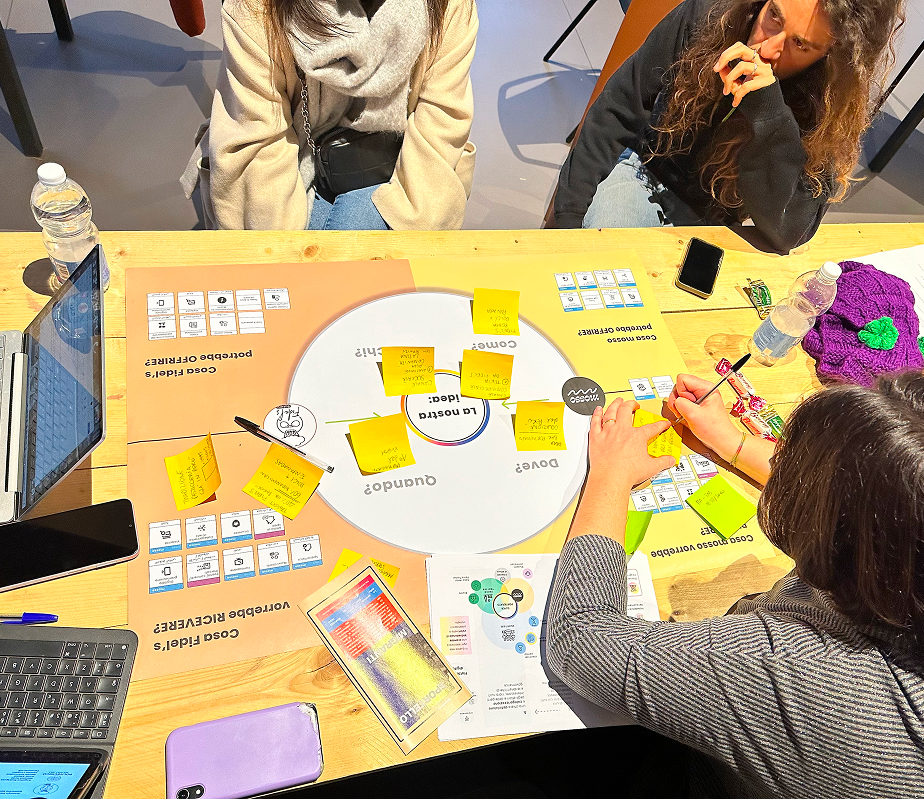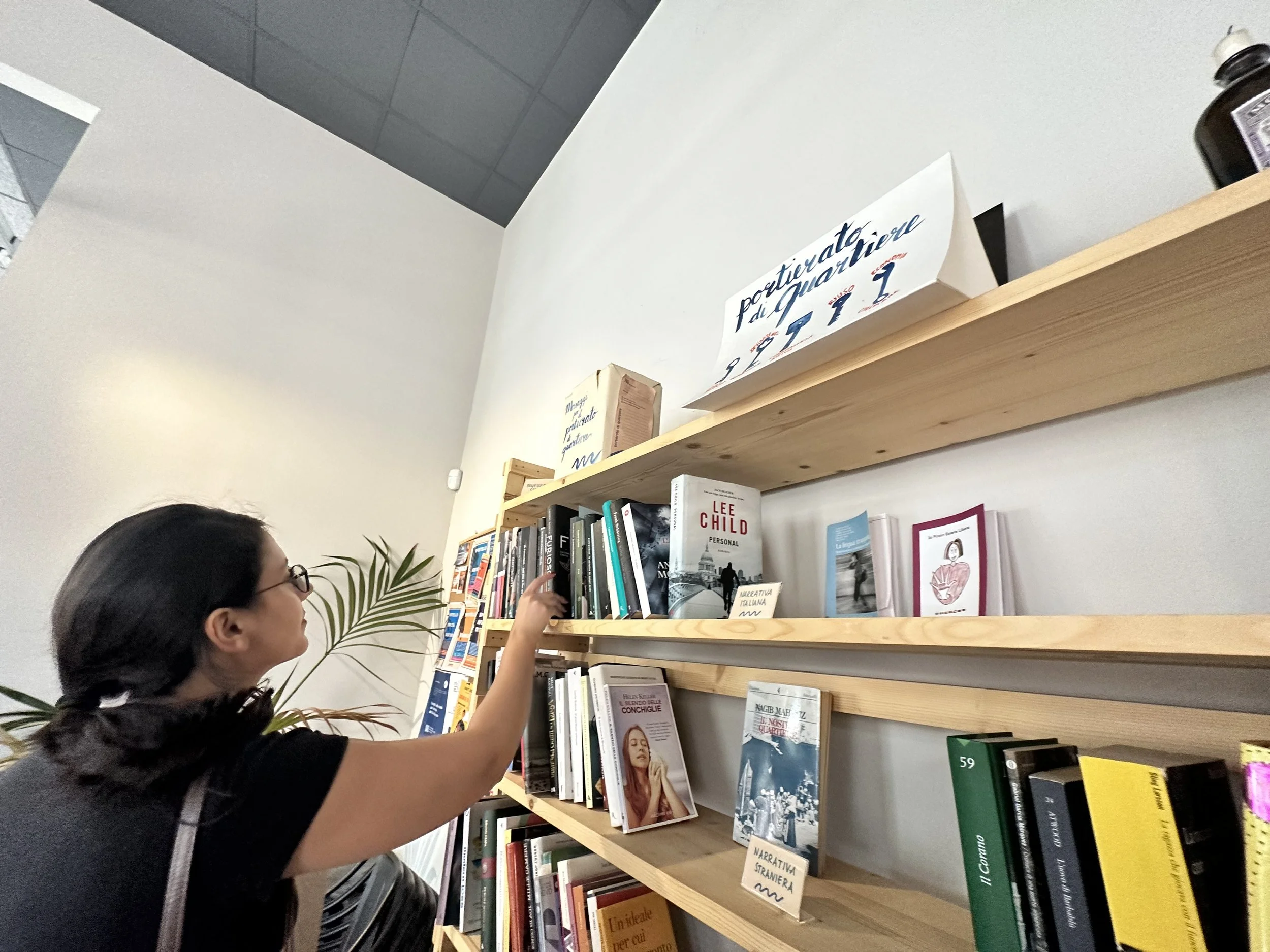Bringing the diverse communities in Via Padova (Milan) together by enhancing Mosso’s community welfare services
Mosso- more than a neighborhood hub
My role
Service designer, design researcher
Project type
Academic project @Politecnico di Milano, 4 months (2023-2024)
Team members
5 others (visual designers, service designers)
Design & research methods
Interviews, observations, co-design sessions, service offering diagram, theory of change, journey maps
Project
Mosso is a neighborhood hub located at Via Padova (Milan). Although it is mostly known for its bar and pizzeria, Mosso actually plays a vital role within the neighborhood by offering multiple welfare services. The brief of the project was to enhance Mosso’s role as the neighbourhood hub and the first point of access in the area by co-designing and implementing further community welfare services.
co-create and enhance the services of Mosso?
amplify the role of Mosso within the community?
How might we:
Output
A new service concept called ‘Mosso super portietrato’ in Italian (in English: Mosso- super neighborhood hub). The concept is based on multiple services offered within a network comprising of Mosso and other local neighborhood businesses. The output included a service offering map, a theory of change and a step-by-step operational strategy and implementation plan.
Impact
Many aspects of the new concept have been implemented by mosso.
Context
mosso is a third sector entity located at the intersection of Via Padova and Via Angelo Mosso in the northeast of Milan (Italy). In its 3000m2 space consisting of an abandoned building next to a historic park and a large square, mosso hosts commercial activities through its pizzeria and bar. Social activities and services are also offered through the help desks (sportelli), tool room & workshop, trainings, and other occasional events.
mosso is situated near the area Via Padova which is a part of Municipo 2 within Milan. It is one of Milan's most densely populated areas, with a population of 37,786 people in 2019. It is one of the most multiethnic and diverse areas of Milan, with a large population of foreigners. The neighborhood has also been stereotyped and stigmatized in terms of security and safety.
There was extensive research conducted to understand the context of Mosso and the neighborhood.
Desk research to understand the current placemaking and urban design projects going on in Milan and near the Via Padova area
Case study analysis of other urban regeneration projects from around the world
Observations within Mosso and around the neighbourhood to immerse ourselves deeply into the context
Interviews with mosso staff, Park (Parco Trotter) staff, local businesses and residents of the neighborhood
Research
Research Methods
Observations
Interviews
Case-study
Analysis
Desk Research


Research Insights
Insights from the neighborhood:
Language barrier, cultural barrier & perceived isolation of communities
Since the area surrounding Mosso is inhabited by people of many different nationalities, the language barrier was ascertained as one of the biggest issues experienced by non-Italians, especially with bureaucratic services.
This may also be one of the reasons that different communities do not mingle much with other communities in the area.
The Via Padova neighborhood
Presence of variety of local businesses
The area surrounding Mosso, including Via Padova, has a wide variety of small local businesses run by both locals and immigrants. There are various small grocery stores (alimentari), barber shops (parrucchieri), bookshops, butcher shops (macellerie), and restaurants etc. The diversity of the businesses gives a vibrance to the area, as customers can be observed coming to all these shops at all times of the day.
Role of local businesses
Local businesses were identified as key spaces for the neighborhood community for not only purchasing products/services that they need, but also to feel a sense of belonging, meet others from their community, and get guidance on the facilities in the neighborhood and advice about bureaucracy as well.
Insights from Mosso:
Many residents and local businesses we interviewed in the neighborhood did not know about mosso at all. Those who did know mosso, knew it only as a bar and a pizzeria, and had no idea about the welfare services or other services that mosso provides.
Identity as a commercial place only
Danger of being a cathedral in the desert
According to different research participants, there was a danger of mosso being "a cathedral in the desert". This means that since mosso is a relatively new entity (1.5 years old), it needs to slowly integrate itself better into its surroundings, in order to not become completely isolated and distanced from its context and the neighborhood residents.
Disconnected communication with the audience about free services
mosso has a small notice board outside the boundary fence where they place the brochures of the tool workshop and sportelli (consultation counters). Inside the bar, there are two noticeboards. One is dedicated to mosso, where the posters about the sportelli are placed. Overall, this is one aspect where we observed that there could be a lot of improvement, as mosso's physical communication is not clear at the moment.
Vision of serving the community & engaging the neighborhood
Luca and Samantha (the managers and representatives of mosso) described how mosso exists to engage and empower everyone in the neighborhood. The aim is to cater to the entire neighborhood, including those who are often neglected, marginalized, or without housing privileges.
Interested in knowing all the research insights in detail?
A community event happening at mosso


Initial Concept
The intial concept was based on the research insight that mosso can often be isolated from its context and location, while local businesses are more in touch with the neighborhood residents and the problems they face or the causes they believe in. Hence, the idea was to connect mosso with local businesses, residents, the park and the overall neighborhood so that it can offer more meaningful services and opportunities for civic engagement.
Co-design Sessions
CODESIGN WITH FORMAL STAKEHOLDERS
To understand the validity of the concept and to develop it further, a series of co-design activities were done with various stakeholders.
The first co-design activity was done in the Park adjacent to mosso where neighborhood citizens often spent their time. From this co-design activity, our concept was validated as people found it interesting and there were many people who did not know about mosso at all. Problems within the neighborhood that could be addressed were also discussed including the language barrier and lack of personalized and directed communication about the activities and initiatives in the neighborhood.
CODESIGN IN THE PARK WITH NEIGHBORHOOD RESIDENTS
Another co-design session was conducted with representatives of the neighborhood, representatives of mosso, and representatives of the various associations within the Park.
We observed that all the participants were engrossed in the discussion, and we realized that this is the first time they have come together for such a trilateral discussion where the neighborhood, mosso, and the entities of Parco Trotter are all represented. Hence, we could see the potential benefits of such a discussion happening regularly. All the participants expressed how the our new concept could effectively solve problems and share resources and knowledge. However, the network must be linked to common objectives for all the stakeholders.
CODESIGN WITH LOCAL BUSINESSES
Co-design activities were held with four different types of local businesses, including aN Egyptian food restaurant, a small Bangladeshi-owner run grocery shop (alimentari), a Peruvian bakery, and an interior decoration shop owned by an Italian. The idea of onboarding local businesses as key partners of mosso in the new network was validated, as all four local businesses showcased a willingness to collaborate with mosso. They were inclined to build a two-way relationship with mosso on a personal and business level, provided that mosso approaches them first and proves to be trustworthy. They were also open to attending and/or initiating cultural exchange events at mosso.


Prototyping and Testing the Concept
Oasis Ponte Lambro has multiple offerings in its service, as showcased in the Offering Map.
WHO WILL BE INVOLVED:
The first persona is Michelle. This persona was inspired by a real CAG user that participated in the interviews and co-design workshop. She represents the main customer segment we are targeting, the youth from Ponte Lambro. Michelle is a 16 years old girl passionate about sports who wants to explore her neighborhood with her friends.
Oasis Ponte Lambro has multiple offerings in its service, as showcased in the Offering Map.
Final Service Concept
WHAT IT IS:
Oasis Ponte Lambro
Well-being and creativity converge at the youth hub of the future, where teens can join guided bike rides, collective sports sessions, augmented reality scavenger hunts and creative workshops. Oasis wants to help foster sustainable practices, build community, and unlock the potential of Ponte Lambro's youth.
This video showcases the new concept for Mosso.
SERVICE OFFERING MAP
(Scroll to see all pages of the map)
Interested in the final concept?
Personal Reflections
What did I learn?
This was one of my first design projects in the context of Milan. I learnt:
How co-design can be an effective tool not only to understand the validity of concepts, but also to empower the involved stakeholders within the ideation, design and decision-making process
Service designers often have to go beyond the given brief and study in detail the context and root causes of a given problem
The value of a multi-cultural team & collaboration, since we were able to reduce the biases in our understanding and ideas by discussing and analysing as a team
Limitations of the project
There were a myriad of limitations in this project. Firstly, there was limited availability of the youth workers and the coordinator within the CAG, hence the research was not as detailed as we liked. Secondly, since we were working with minors, often we would only get to engage very few teenagers in our interviews/co-design, so we had to work with a limited sample size. Thirdly, the timelines of the course (within which we were doing this project) would not match the timelines and pace at which the CAG and the Municipality works. Hence the rushed pace of the course often affected the quality of the output.
What would I improve or change?
I would change the timeline of the project, so that more research sessions and co-design sessions can be held not only with the youth workers at the CAG but also with the parents and other community members of the neighborhood.



































